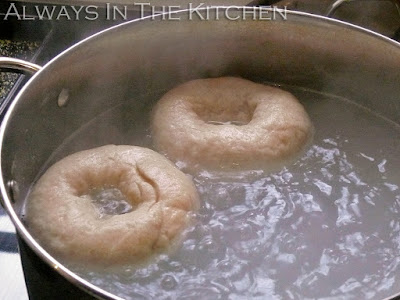
Pannkakor are less of a breakfast food in Sweden and more often served as lunch/dinner, supper, or dessert. Most famously, pannkakor are served on Thursdays after a bowl of yellow pea soup (with or without ham, drizzled with mustard). They appear on school lunch trays, on hospital menus, and in heat-and-serve portions at the supermarket (complete with lingon berry preserves).
The number of pancakes you get will be determined partly by the size of the pan you use, and partly by the size of the eggs in your batter, partly how much batter you pour.
Klassiska Svenska Pannkakor
Classic Swedish Pancakes
(Translated and adapted from Pannkakor.se)
Makes approximately 11-12 thin pancakes, if using a 28 cm skillet
250 ml (1 cup) all purpose flour
1/2 teaspoon coarse salt
600 ml milk
3 large eggs
3 tablespoons butter, divided
In a large mixing bowl, preferably one with a spout for pouring, mix the flour and salt. Add 250 ml of the milk, and whisk until the batter is smooth. Add the remaining 350 ml of milk and whisk to combine. Add all three eggs, and whisk again until completely smooth and integrated, with no streaks of yolk in the batter.
Let the batter rest at room temperature for 30 minutes. Close to the end of this time, preheat a 28cm non-stick skillet (or well-seasoned cast iron, if you have wrists of steel) over medium heat. At the same time, set your oven to warm and place a large "resting plate" on the middle or lower middle rack, so it will be ready to receive the pancakes as they come off the pan.
Melt the butter in a small bowl. add 22.5 mL (1.5 tablespoons) of melted butter to the pancake batter, and whisk through. The rest of the melted butter will be used to fry the pancakes, a little at a time between each pancake.
When the skillet is hot, just before you pour your first pancake, use a pastry brush to brush a little butter over the cooing surface of the hot pan. I measure my batter by pouring it into an actual measuring cup first, so that my pancakes are consistently sized If you have a ladle that is the right size, that will work well too. Pour 80 ml (1/3 cup dry measure cup) of batter into the buttered pan, and quickly lift and tilt the skillet so that the batter covers the bottom of the skillet in a thin layer, trying not to go up the sides of the pan.
Let the pancake cook for about 2 minutes - if you try to flip it too soon, it will tear, so be patient. If you are concerned that it is cooking too quickly, reduce the heat instead of reducing the cooking time. When the two minutes are up, slide a spatula carefully under and around the edge of the pancake, and then slide it beneath to quickly lift and turn the pancake. This may take a bit of practise to get a smooth action, but you have a lot of batter with which to practise. The cooked side of the pancake should look a bit lacy and browned in spots, like in the picture above.
Let the pancake cook on the second side for about 30 seconds, or until set, and then slide it onto the resting plate in the oven.
Put the skillet on a unheated burner. Brush with melted butter, add the next portion of batter and tilt to spread the batter, and immediately return the skillet to the hot burner (medium heat). This helps keep the skillet from overheating, and prevents the butter (and the next pancake) from burning. Continue as before, stacking up the pancakes until all the batter is used. You may need to gradually reduce the heat under the burner as you work your way through the batter, so if the pancakes are getting too dark, or dark too quickly, reduce the heat a little as you go.
If there is any melted buter left over at this point, it can be brushed over the top pancake(s) for a little extra luxury.
Pancakes are traditionally served with lingon berry preserves, or fresh berries and whipped cream, but you can also use syrup (maple, birch, any fruit syrup, chocolate) or, of course, any other fillings you choose.

Swedish proverbs featuring pancakes
Man matar inte grisar med pannkakor.
➔ One doesn't feed pigs with pancakes.
Man är aldrig säker förrän hon ligger i magen, sa pojken som tappade pannkakan i askan.
➔ You're never certain until it's in your belly, said the boy who dropped the pancake in the ashes.
Upp som en sol och ner som en pannkaka.
➔ Up like a sun, and down like a pancake.
















































